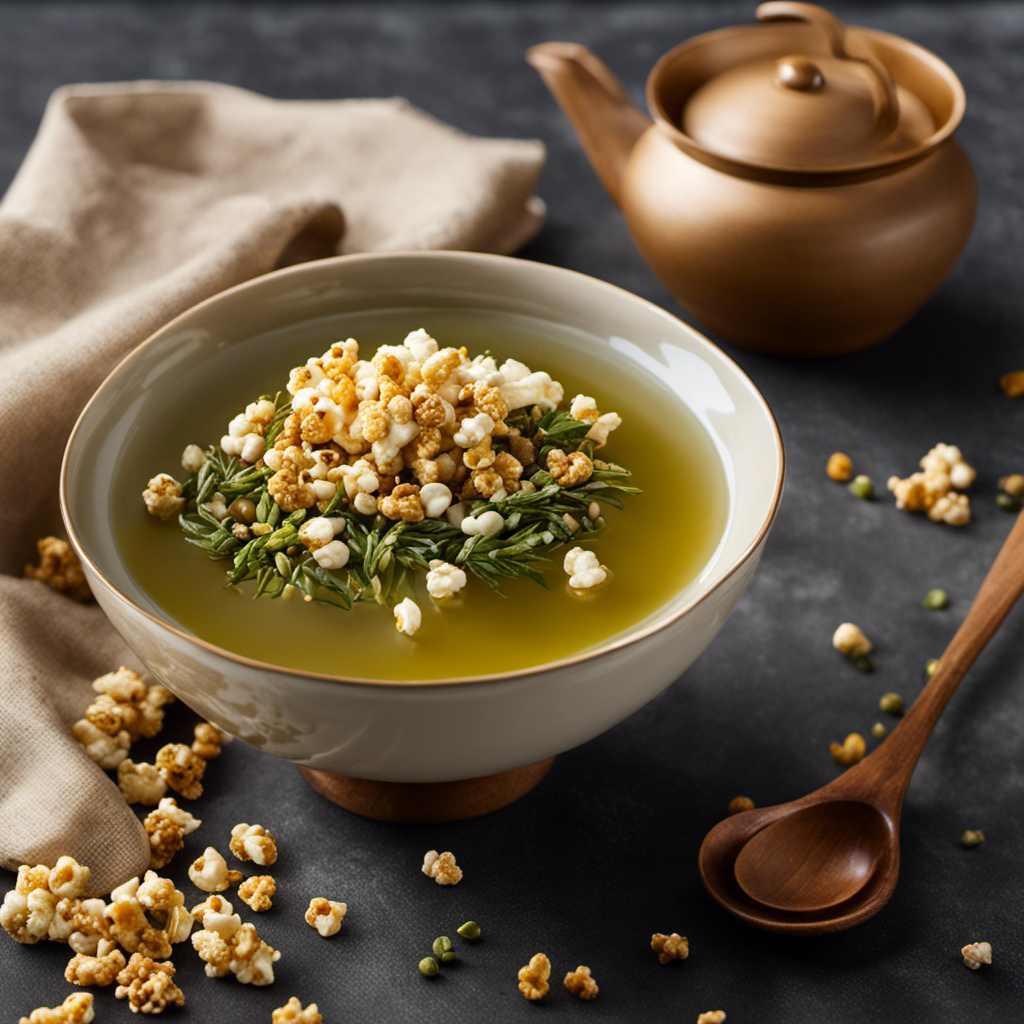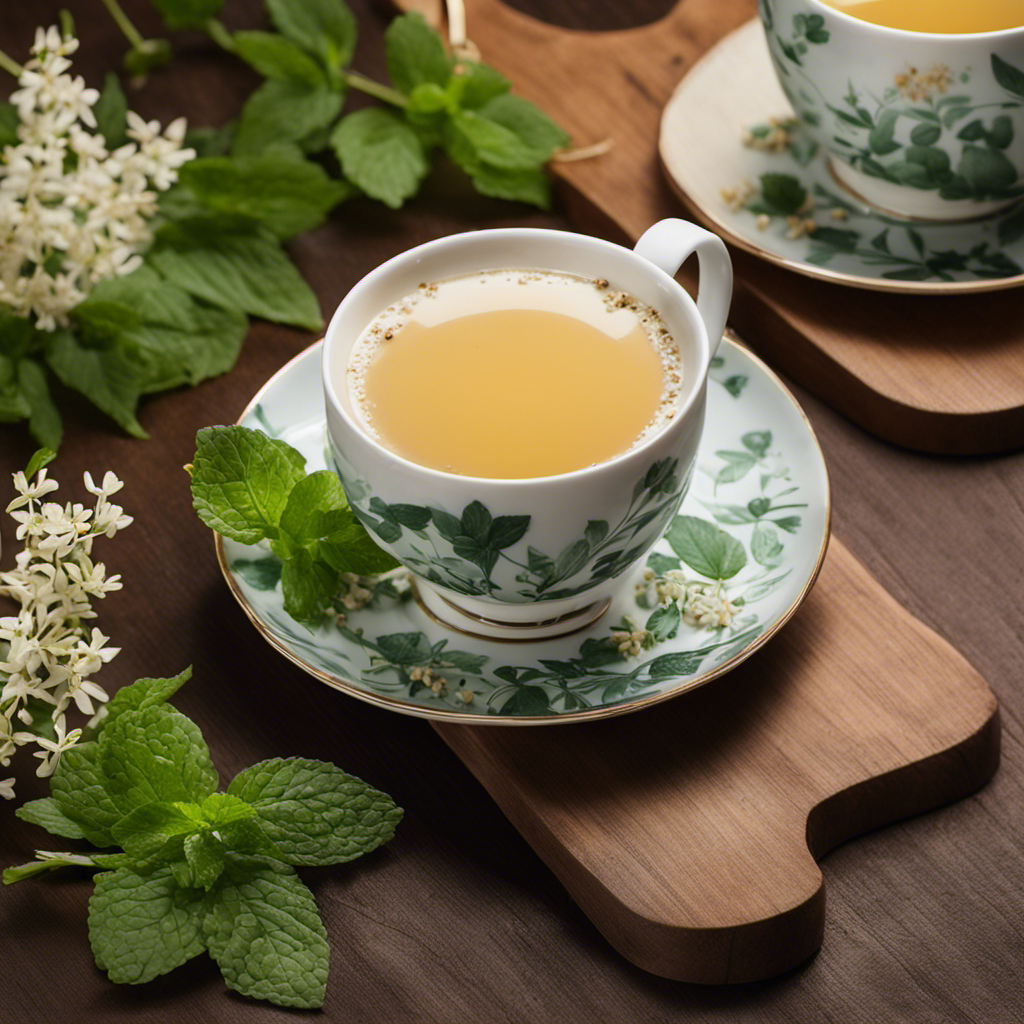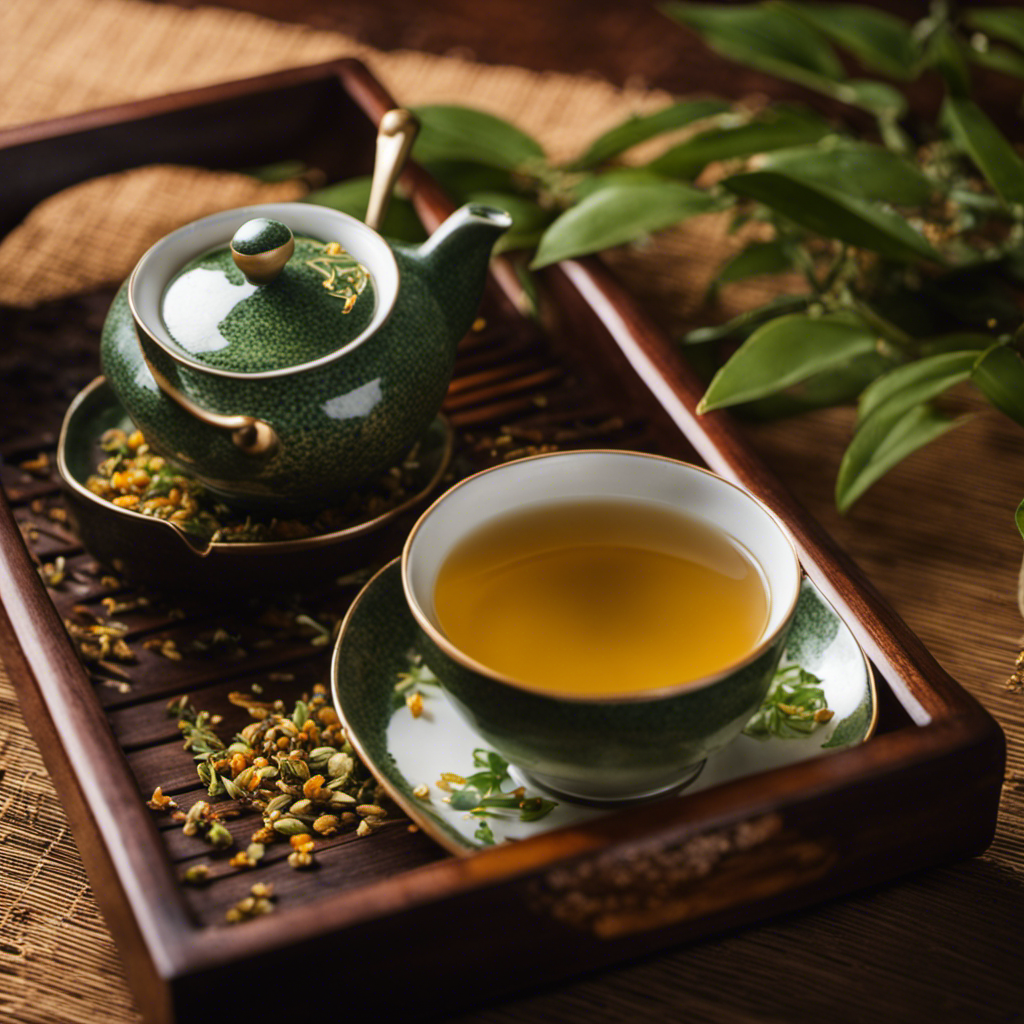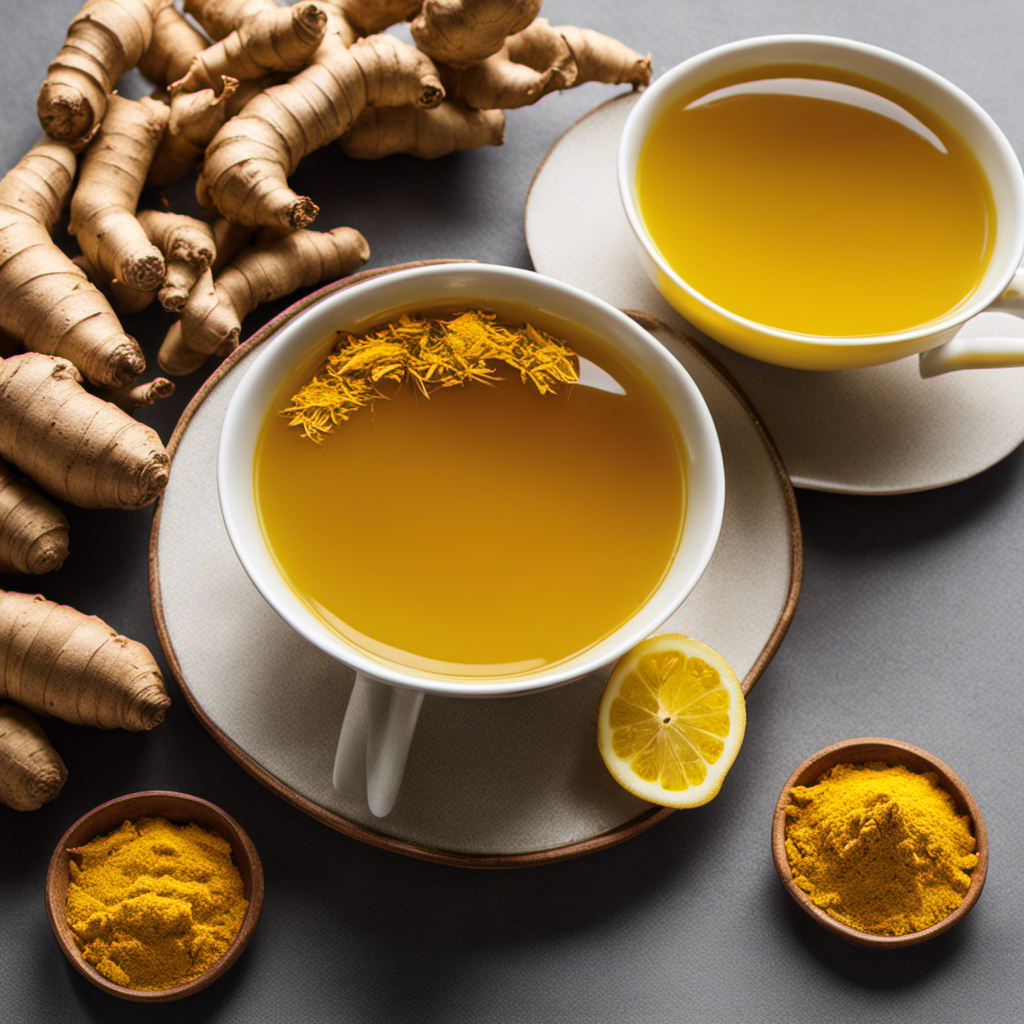Genmaicha
The Delightful Harmony Of Genmaicha: Exploring The Warm Nuttiness Of Oatmeal And Popcorn

I’ve always been intrigued by how various flavors unite to form a genuinely harmonious sensation. In the realm of tea, the blend that consistently delights my palate is genmaicha.
The delightful marriage of toasted rice and green tea leaves creates a flavor profile unlike any other. It’s like the warm nuttiness of oatmeal and the satisfying crunch of popcorn, all wrapped up in a cup of tea.
Genmaicha has a rich history, originating from times of economic hardship when tea supplies needed to be stretched. But what started as a clever solution has now become a worldwide sensation. Producers constantly experiment with different teas and ratios to perfect the genmaicha flavor, selecting the highest quality leaves from farmers across Japan.
Whether you’re a beginner or a seasoned tea enthusiast, genmaicha is a must-try. So join me on a journey to explore the warm nuttiness of oatmeal and popcorn in the delightful harmony of genmaicha.
Key Takeaways
- Genmaicha is a Japanese green tea made by combining toasted rice with tea leaves, resulting in a warm, nutty flavor.
- The flavor profile of genmaicha is a harmonious blend of warm, nutty rice flavors and slightly sweet, grassy tea flavors.
- Genmaicha flavor can be described as sweet, warm, roasted, nutty, buttery, and chocolaty, with hints of oatmeal and popcorn.
- Genmaicha is a popular type of Japanese blended tea worldwide, enjoyed by beginners as an introduction to Japanese green tea.
What is Genmaicha?
I already know that Genmaicha is a Japanese green tea that combines toasted rice with tea leaves, resulting in a warm, nutty flavor. It’s a unique and delightful tea that has gained popularity worldwide.
The combination of the toasted rice and the fresh, vegetal flavors of the tea leaves creates a harmonious flavor profile that is both comforting and delicious. Genmaicha pairs well with a variety of snacks, such as mixed nuts and popcorn, enhancing the overall taste experience.
Additionally, it can be enjoyed alongside bancha, another low caffeine green tea, for a well-rounded tea session. Whether you’re a beginner or a seasoned tea enthusiast, Genmaicha offers a soothing and enjoyable tea-drinking experience that is sure to delight your taste buds.
Flavor Profile
The flavor profile of genmaicha combines the warm, nutty notes of toasted rice with the fresh, vegetal flavors of green tea leaves. It’s a delightful harmony of flavors that’s truly unique.
When sipping genmaicha, you may notice hints of oatmeal and popcorn, adding to its charm. Compared to other teas, genmaicha stands out with its sweet, warm, roasted, nutty, buttery, and even chocolaty undertones. It’s like a comforting bowl of warm cereal or a lighter cup of coffee.
To enhance the genmaicha experience, experimenting with different brewing techniques can make a difference. Adjusting the water temperature and brewing time can bring out different aspects of the flavor profile. So why not try brewing genmaicha at 175 degrees Fahrenheit (80 degrees Celsius) for 1 minute and see how the flavors unfold? It’s an exploration worth embarking on.
History and Production
During times of economic hardship, Japanese tea makers created genmaicha by combining toasted rice with tea leaves to stretch out their limited tea supplies. This innovative blend not only helped them make the most of their resources but also gave birth to a unique and beloved tea flavor.
Today, genmaicha has become the most popular type of Japanese blended tea worldwide. Producers of genmaicha continue to experiment with different teas and ratios to create the perfect flavor. Each producer adds their own twist, resulting in a variety of genmaicha flavors available in the market. Some blends have a stronger nutty taste, while others may have a more pronounced grassy note. This diversity allows tea lovers to explore and find their perfect genmaicha flavor.
The experimentation and dedication of genmaicha producers ensure that every cup of this delightful tea is a unique and enjoyable experience. So, next time you sip on a warm and comforting cup of genmaicha, take a moment to appreciate the craftsmanship behind its creation.
Frequently Asked Questions
What are the health benefits of drinking genmaicha?
Genmaicha offers several health benefits. It can aid in weight loss due to its low calorie content and metabolism-boosting properties. Additionally, genmaicha can be a great alternative to coffee, providing a gentle energy boost without the jitters.
Can genmaicha be enjoyed with milk or sweeteners?
When it comes to exploring the taste profile of genmaicha with milk or sweeteners, I must debunk the myth that genmaicha is bland without them. The warm, nutty flavors of genmaicha shine through beautifully on their own, creating a delightful and satisfying experience.
How does the toasting process affect the flavor of the rice in genmaicha?
The toasting process in genmaicha enhances the flavor of the rice, giving it a warm, nutty taste. The rice becomes slightly caramelized, adding depth and richness to the tea. It’s this toasting process that creates the delightful harmony of genmaicha.
Are there any specific regions in Japan known for producing high-quality genmaicha?
In Japanese tea culture, genmaicha holds a special place alongside other traditional teas. It is a unique twist on green tea, incorporating toasted rice for a warm, nutty flavor. Different regions in Japan produce high-quality genmaicha with their own distinct variations.
Can genmaicha be brewed using a teapot or is it best brewed using a different method?
Yes, genmaicha can be brewed using a teapot, but there are also alternative methods. Some people prefer to use a kyusu, a traditional Japanese teapot, to enhance the flavors. Others use a tea infuser or a teacup with a built-in strainer for convenience.
Conclusion
As I take my last sip of genmaicha, I can’t help but marvel at the delightful harmony of flavors in my cup. The warm, nutty taste of toasted rice blends seamlessly with the fresh, grassy notes of the tea leaves. It’s like a symphony of oatmeal and popcorn, with hints of caramel and warm cereal.
The history and production of genmaicha only add to its allure, as it was born out of necessity during times of hardship. Now, it has become the most popular Japanese blended tea worldwide. I’m grateful for this coincidental creation, which brings joy to tea lovers everywhere.
Arf, an author and an innovative enthusiast of coffee, coffee alternatives, and tea, plays a crucial role as a contributor to the esteemed Cappuccino Oracle platform. Renowned for his curiosity and passion for these captivating beverages, Arf has carved out a unique space for himself in the world of exploration and writing. He realized that coffee, coffee alternatives, and tea are not mere drinks to keep one awake, but universes of flavors and stories waiting to be explored.
Arf’s articles for Cappuccino Oracle blend meticulous research with personal experiences, providing readers with an in-depth understanding of various types of coffee, coffee alternatives, and tea, along with their unique characteristics, cultures, and histories. His honest reviews and engaging narratives guide readers on their own journeys, helping them discover their preferences and find their perfect brew.
Genmaicha
Delicious Genmaicha Milk Tea: The Ultimate Recipe!

There is a popular expression, ‘A cup of tea is akin to receiving a warm embrace in a mug.’ This sentiment is especially accurate when it pertains to genmaicha milk tea.
This delightful Japanese beverage combines the nutty flavors of genmaicha tea with the creamy goodness of milk, creating a harmonious blend that is both comforting and invigorating.
As a tea enthusiast, I have always been captivated by the unique flavor profile of genmaicha, with its toasted rice and green tea leaves. So, when I discovered the magic of genmaicha milk tea, I knew I had stumbled upon something truly special.
In this article, I will share with you the ultimate recipe for making delicious genmaicha milk tea at home. From the perfect steeping time to the ideal milk ratio, I will guide you through the process of creating a cup of genmaicha milk tea that will warm your soul and tantalize your taste buds.
So, get ready to indulge in the ultimate tea experience with genmaicha milk tea.
Key Takeaways
- Genmaicha milk tea is a popular Japanese tea beverage that combines genmaicha tea with milk.
- This recipe teaches you how to make it at home for a fraction of the price.
- Genmaicha milk tea is a perfect balance of savory and sweet.
- Experiment with different types of milk, sweeteners, or additional flavors like vanilla or caramel.
What is it?
Genmaicha milk tea is a delightful Japanese beverage that combines the nutty flavor of genmaicha tea with creamy milk. This unique blend creates a harmonious balance of flavors that’s both comforting and delicious.
The health benefits of genmaicha milk tea are numerous. Genmaicha tea is known for its high antioxidant content, which can help boost the immune system and promote overall well-being. Additionally, the combination of tea and milk provides a dose of calcium and protein.
To brew the perfect cup of genmaicha milk tea, start by steeping the tea for at least 1 minute or longer for a stronger taste. Then, strain the tea into a cup or glass.
Heat your choice of milk, whether it’s cow’s milk or a non-dairy alternative, until hot. Use a frother or steam wand to froth the milk until creamy. Finally, pour the brewed tea into a cup or glass, add the frothed milk, and sweeten to taste.
With these tips, you can enjoy a delicious cup of genmaicha milk tea that’s both flavorful and beneficial for your health.
Ingredients and Preparation
To create a perfect harmony of flavors, the nutty aroma of roasted rice dances elegantly with the smoothness of creamy milk in this traditional Japanese tea beverage. When making genmaicha milk tea, you have the flexibility to choose from different types of milk. Cow’s milk provides a classic and rich taste, while non-dairy milk options like almond or oat milk offer a delightful twist.
Genmaicha tea itself is packed with benefits. It contains antioxidants that may help boost the immune system and improve digestion. The combination of genmaicha tea and milk creates a unique flavor profile that is both savory and sweet. The milk adds a creamy texture that complements the earthy notes of the tea.
So go ahead, experiment with different types of milk and enjoy the delicious and comforting experience of genmaicha milk tea.
Variations and Customizations
When customizing genmaicha milk tea, there are endless possibilities to explore. It’s all about finding the perfect combination that suits your taste buds. Here are a few ideas to get you started:
-
Different types of milk to use:
- Whole milk: This’ll give your genmaicha milk tea a rich and creamy texture.
- Almond milk: For those who prefer a dairy-free option, almond milk adds a subtle nutty flavor.
- Oat milk: Creamy and slightly sweet, oat milk is a great alternative that pairs well with genmaicha’s toasty notes.
-
Different types of sweeteners:
- Honey: Add a touch of natural sweetness with honey, which complements the earthy flavors of genmaicha.
- Maple syrup: Give your tea a hint of caramel-like sweetness with maple syrup.
- Brown sugar: For a deeper, molasses-like sweetness, brown sugar is a great choice.
Remember, these’re just a few suggestions. Feel free to experiment with other milk alternatives or sweeteners to create your own unique genmaicha milk tea experience. Enjoy the process of customizing and happy sipping!
Frequently Asked Questions
How long does genmaicha milk tea stay fresh?
The shelf life of genmaicha milk tea can vary depending on the ingredients used. To ensure freshness, store it in an airtight container in the refrigerator for up to 2-3 days. This is the best storage method for genmaicha milk tea.
Can I use any type of milk for genmaicha milk tea?
You can use different types of milk alternatives for genmaicha milk tea, such as almond, soy, or oat milk. Each milk has its own unique flavor and benefits, adding depth and richness to the tea. Experiment and find your favorite combination!
Can genmaicha milk tea be served cold?
Serving Genmaicha milk tea cold has its pros and cons. The pros include a refreshing and cooling drink, perfect for hot weather. Different variations can be made, such as adding ice or blending it into a smoothie. However, the cons are that the flavors may not be as pronounced, and the tea may become diluted.
Can I use a different type of sweetener for genmaicha milk tea?
Yes, you can absolutely use a different type of sweetener for your genmaicha milk tea! Popular options include honey, agave syrup, or even stevia for a healthier alternative. Genmaicha milk tea also offers numerous health benefits, such as boosting metabolism and providing antioxidants.
Can I make genmaicha milk tea without a frother or steam wand?
Yes, you can still make delicious genmaicha milk tea without a frother or steam wand. One alternative method is to vigorously shake hot milk in a tightly sealed container until it becomes frothy. Another option is to use a whisk to manually froth the milk.
Conclusion
In conclusion, making a delicious cup of genmaicha milk tea is a delightful experience that brings comfort and joy. It’s a harmonious blend of genmaicha tea and creamy milk, creating a perfect balance of flavors. By following the simple steps outlined in this recipe, you can easily create your own version of this beloved Japanese tea beverage.
Whether you prefer it hot or iced, sweetened or unsweetened, genmaicha milk tea is a versatile drink that can be customized to suit your taste. So, go ahead and indulge in this delightful concoction, and let the soothing flavors transport you to a world of serenity and bliss.
Cheers to the ultimate genmaicha milk tea experience!
Arf, an author and an innovative enthusiast of coffee, coffee alternatives, and tea, plays a crucial role as a contributor to the esteemed Cappuccino Oracle platform. Renowned for his curiosity and passion for these captivating beverages, Arf has carved out a unique space for himself in the world of exploration and writing. He realized that coffee, coffee alternatives, and tea are not mere drinks to keep one awake, but universes of flavors and stories waiting to be explored.
Arf’s articles for Cappuccino Oracle blend meticulous research with personal experiences, providing readers with an in-depth understanding of various types of coffee, coffee alternatives, and tea, along with their unique characteristics, cultures, and histories. His honest reviews and engaging narratives guide readers on their own journeys, helping them discover their preferences and find their perfect brew.
Genmaicha
Cold Brew Genmaicha: A Refreshing Twist On A Classic Tea

Are you aware that genmaicha cold brew is gaining more and more traction with tea lovers? Absolutely! This cooler version of the traditional tea is created by infusing the tea leaves in cold water, leading to a flavor that is both sweeter and more mellow than what you’d get with conventional hot brewing techniques.
Not only does this method extract more catechins, but it also brings out delightful caramel notes from the toasted rice in genmaicha. Perfect for those scorching summer days when you need a cool and revitalizing beverage.
But wait, there’s more! Iced genmaicha, made by brewing the tea leaves with melting ice cubes, is another fantastic option that offers a sweeter and more refreshing taste.
In this article, we will explore the various methods of preparing genmaicha, including cold brew and ice brew, as well as provide you with recipes for genmaicha-infused treats. Get ready to embark on a journey of refined taste and discover the wonders of cold brew genmaicha.
Key Takeaways
- Cold brew genmaicha is made by brewing the tea leaves with cold water instead of warm water.
- Cold brew genmaicha has a sweeter and smoother flavor compared to hot brew.
- Cold brew genmaicha extracts more catechins, the bitter components of tea leaves.
- Ice brew genmaicha is a method to make a perfect iced genmaicha.
What is it?
Cold brew genmaicha is a method of brewing tea leaves with cold water instead of warm water, resulting in a sweeter and smoother flavor profile compared to hot brew. To make cold brew genmaicha, simply add the tea leaves to a pitcher or jar, pour in cold water, and let it steep in the refrigerator for several hours or overnight.
The longer the steeping time, the stronger the flavor will be.
The main difference between cold brew and hot brew genmaicha lies in the taste. Cold brew genmaicha has a milder and more delicate flavor, with the cold water extracting fewer tannins and catechins, which are responsible for the bitter taste in tea. Instead, it brings out the pleasant caramel notes from the toasted rice, resulting in a sweeter and smoother taste.
Overall, cold brew genmaicha is a refreshing twist on the classic tea, perfect for hot summer days or when you want a lighter and more refreshing option.
Benefits and Flavor Profile
I love how the flavor profile of cold brew genmaicha is different from the hot brew, with its sweeter and smoother taste. When brewing genmaicha with cold water, it extracts more catechins, which are the bitter components of tea leaves. This results in a tea that is not only delicious but also packed with health benefits.
Cold brew genmaicha is known for its high antioxidant content, which can help boost the immune system and promote overall well-being. Additionally, the cold water brings out pleasant caramel notes from the toasted rice in genmaicha, adding a unique depth of flavor.
To make the perfect cold brew genmaicha, simply steep the tea leaves in cold water for several hours and then strain. It’s a simple and refreshing way to enjoy this classic tea.
Ice Brew Method
One popular method to make a perfect iced genmaicha is by using the ice brew technique. This method involves brewing the tea leaves with melting ice cubes in a kyusu teapot. The melting ice cubes create an extremely low temperature, resulting in a sweeter infusion.
Ice brew genmaicha is a refreshing option for enjoying this classic tea in a new way. It’s especially popular in high-end tea shops in Japan, where it’s known for its delicate and refreshing flavor.
If you’re looking for alternative brewing methods for genmaicha or iced tea recipes, the ice brew method is definitely worth a try. Its unique combination of flavors and the low temperature infusion create a truly unique and enjoyable iced genmaicha experience.
Frequently Asked Questions
How long does it take to cold brew genmaicha?
To cold brew genmaicha, simply combine 1 part tea leaves with 4 parts cold water and steep in the refrigerator for 8-12 hours. The best temperature for cold brewing genmaicha is around 40-50°F. The result is a deliciously sweet and smooth tea.
Can I use any type of genmaicha for cold brewing?
You can use any type of genmaicha for cold brewing. The benefits of cold brewing genmaicha include a sweeter and smoother flavor profile, as well as extracting more catechins. It’s a refreshing twist on a classic tea.
Does cold brew genmaicha have the same health benefits as hot brew?
Cold brew genmaicha offers a unique twist on the classic tea, with a sweeter and smoother flavor. While both hot and cold brew genmaicha have health benefits, the nutritional differences may vary due to the extraction process.
Can I add sweeteners or milk to cold brew genmaicha?
Adding sweeteners and milk to cold brew genmaicha is a matter of personal preference. Sweeteners like honey or agave can enhance the flavors, while milk or cream can add a creamy texture. However, it’s important to note that these additions may alter the original taste and health benefits of the tea.
Can I reuse the tea leaves from cold brew genmaicha for a second infusion?
Yes, you can reuse the tea leaves from cold brew genmaicha for a second infusion. However, keep in mind that the flavor will be more subtle and the caramel notes from the toasted rice may not be as pronounced. Experiment to find your preferred flavor variations.
Conclusion
In conclusion, cold brew genmaicha is a delightful and refreshing variation of the classic tea. Its unique brewing method extracts more catechins, resulting in a sweeter and smoother flavor. The combination of cold water and toasted rice brings out delightful caramel notes, making it a perfect choice for hot summer days.
For an even more exquisite experience, ice brew genmaicha is a popular option in high-end tea shops, creating a sweet and refreshing iced tea.
Whether enjoyed hot or cold, genmaicha offers a truly exceptional and refined taste.
Arf, an author and an innovative enthusiast of coffee, coffee alternatives, and tea, plays a crucial role as a contributor to the esteemed Cappuccino Oracle platform. Renowned for his curiosity and passion for these captivating beverages, Arf has carved out a unique space for himself in the world of exploration and writing. He realized that coffee, coffee alternatives, and tea are not mere drinks to keep one awake, but universes of flavors and stories waiting to be explored.
Arf’s articles for Cappuccino Oracle blend meticulous research with personal experiences, providing readers with an in-depth understanding of various types of coffee, coffee alternatives, and tea, along with their unique characteristics, cultures, and histories. His honest reviews and engaging narratives guide readers on their own journeys, helping them discover their preferences and find their perfect brew.
Genmaicha
Creating Your Own Genmaicha: The Art Of Toasted Rice Tea

Were you aware that genmaicha, often referred to as toasted rice tea, holds a cherished place in the world of Japanese tea traditions? By blending the hearty flavors of toasted brown rice with the essence of green tea leaves, genmaicha provides a distinct and gratifying flavor adventure.
And here’s the exciting part – you can create your own genmaicha at home! By controlling the quality and freshness of the ingredients, making your own genmaicha not only ensures a delicious cup of tea but also gives you the opportunity to explore different flavor combinations. Maybe you prefer a stronger green tea flavor, or perhaps you’d like to experiment with adding matcha powder for an extra kick. The possibilities are endless.
Not only is creating your own genmaicha a fun and rewarding experience, but it also allows you to deepen your understanding of different green tea flavors. So, let’s dive into the art of toasted rice tea and unlock a world of tea-sipping pleasure.
Key Takeaways
- Using high-quality tea leaves is important for making genmaicha.
- Experimenting with the proportion of tea leaves to rice can enhance the flavor.
- Genmaicha is a Japanese green tea made by mixing roasted brown rice with green tea leaves, known for its unique and delicious flavor.
- Making your own genmaicha allows for control over the quality and freshness of ingredients, is cost-effective, and can be a fun and educational activity.
Tips and Proportions
I’ve learned that when making my own genmaicha, it’s important to use high-quality tea leaves and experiment with the proportion of tea leaves to rice. Experimenting with different types of tea leaves, such as Sencha or Bancha, can greatly enhance the flavor of the genmaicha.
In Japan, genmaicha has a long history and cultural significance, being a staple in Japanese tea culture for centuries. It’s enjoyed for its unique and delicious flavor, with nutty and toasty notes. By making my own genmaicha, I have the opportunity to control the quality and freshness of the ingredients, as well as customize the flavor to my liking.
It’s a rewarding and enjoyable experience that allows me to explore the art of toasted rice tea.
Description and Benefits
Using high-quality tea leaves and experimenting with the proportion of tea leaves to rice are important tips for making genmaicha. Here are some key aspects to consider when creating your own genmaicha:
- Control the quality and freshness of ingredients.
- Cost-effective compared to buying pre-packaged tea.
- Educational activity to improve understanding of green tea flavors.
- Fun activity to do with friends and family.
Additionally, genmaicha offers different flavor variations:
- Add matcha powder for a richer and more complex flavor.
- Include hojicha, a low caffeine Japanese green tea, for a different taste profile.
By exploring these variations, you can create unique genmaicha blends that suit your taste preferences. Making genmaicha not only provides a rewarding and enjoyable experience but also allows you to enjoy the benefits of a healthy and refreshing drink.
Creativity and Versatility
Let’s dive into the world of genmaicha and explore its endless possibilities, like a blank canvas waiting to be filled with vibrant flavors and innovative creations.
When it comes to genmaicha, there’s no limit to the flavor variations you can experiment with. From adding a touch of matcha powder for a richer and more complex taste, to incorporating hojicha for a different flavor profile, the options are truly endless.
But the creativity doesn’t stop there. When it comes to garnishing and serving genmaicha, you can let your imagination run wild.
Imagine a genmaicha cake, a decadent treat that combines the comforting flavors of toasted rice tea with a moist and fluffy cake. Or how about brown butter matcha brownies or cookies, where the nutty notes of toasted rice perfectly complement the richness of butter and the earthiness of matcha.
And for a refreshing twist, try a matcha strawberry cake, where the sweetness of strawberries balances the nutty and toasty flavors of genmaicha.
With genmaicha, the possibilities are truly limitless, allowing you to unleash your creativity and indulge in the versatility of this beloved tea.
Frequently Asked Questions
How long does it take to make genmaicha toasted rice tea?
The cooking time for making traditional genmaicha toasted rice tea can vary depending on the desired strength and flavor. Generally, it takes about 10-15 minutes to prepare, making it a quick and enjoyable process.
Can I use any type of rice to make genmaicha?
Using unconventional rice varieties for genmaicha can result in unique flavor variations. Experimenting with different rice types such as jasmine or black rice adds a delightful twist to the traditional nutty and toasty notes of genmaicha.
What are some common mistakes to avoid when making genmaicha?
When making genmaicha at home, it’s important to avoid common mistakes. One common mistake is using low-quality tea leaves, which can result in a lackluster flavor. Another mistake is not properly toasting the rice, leading to a less aromatic brew.
Can I add other flavors or ingredients to genmaicha?
Yes, you can add various flavors and ingredients to genmaicha tea to enhance its taste and health benefits. Some popular options include adding matcha powder for a richer flavor or using hojicha for a different taste profile.
Can genmaicha be enjoyed hot or cold?
Hot or cold, genmaicha is a versatile and refreshing drink. Enjoy it hot for a comforting and warming experience, or chilled for a cool and revitalizing treat. Both ways offer the health benefits of genmaicha, including antioxidants and a soothing aroma.
Conclusion
In conclusion, creating your own genmaicha is a delightful and rewarding endeavor that allows you to have full control over the quality and flavor of your tea. By experimenting with different proportions of tea leaves and rice, you can craft a genmaicha that perfectly suits your taste preferences.
The versatility of genmaicha extends beyond a simple cup of tea, as it can be incorporated into various recipes for a unique culinary experience. Did you know that genmaicha is the second most popular tea in Japan, after sencha? This statistic highlights its widespread popularity and the appreciation for its distinct nutty flavor.
So why not embark on this artful journey and indulge in the pleasures of creating your own genmaicha?
Arf, an author and an innovative enthusiast of coffee, coffee alternatives, and tea, plays a crucial role as a contributor to the esteemed Cappuccino Oracle platform. Renowned for his curiosity and passion for these captivating beverages, Arf has carved out a unique space for himself in the world of exploration and writing. He realized that coffee, coffee alternatives, and tea are not mere drinks to keep one awake, but universes of flavors and stories waiting to be explored.
Arf’s articles for Cappuccino Oracle blend meticulous research with personal experiences, providing readers with an in-depth understanding of various types of coffee, coffee alternatives, and tea, along with their unique characteristics, cultures, and histories. His honest reviews and engaging narratives guide readers on their own journeys, helping them discover their preferences and find their perfect brew.
-

 Mushroom Coffee6 days ago
Mushroom Coffee6 days agoYour Ultimate Guide to Ryze Mushroom Coffee: 9 Things to Know
-

 Mushroom Coffee6 days ago
Mushroom Coffee6 days agoUnveiling the Puzzle: Top 10 Alternatives to Ryze Mushroom Coffee Revealed
-

 Mushroom Coffee6 days ago
Mushroom Coffee6 days agoUnveiling the Mysteries of Ryze Mushroom Coffee: Top 10 Questions Answered
-

 Cappuccino Oracle Selected Reviews4 weeks ago
Cappuccino Oracle Selected Reviews4 weeks agoPuroAir HEPA 14 Air Purifier Review
-

 Cappuccino Oracle Selected Reviews4 weeks ago
Cappuccino Oracle Selected Reviews4 weeks agoArctic Air Pure Chill 2.0 Review: Cool and Portable
-

 Mushroom Coffee6 days ago
Mushroom Coffee6 days ago3 Best Techniques to Brew Ryze Mushroom Coffee
-

 Coffee Basics1 week ago
Coffee Basics1 week agoHow Do Starbucks’ Seasonal Specialties Appeal to Customers?
-

 Cappuccino Oracle Selected Reviews4 weeks ago
Cappuccino Oracle Selected Reviews4 weeks agoNineSky Dehumidifier Review: A Game-Changer for Comfort















